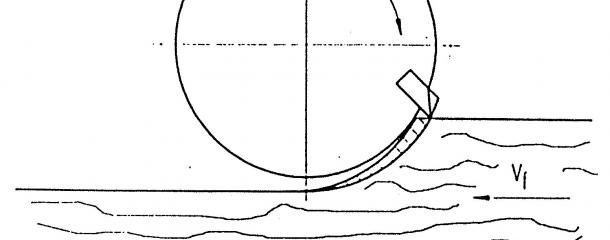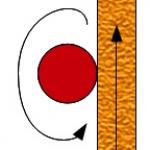Rotation in feed directionDescribes the rotation of a rotatable, cylindrical machine part (e.g. cutter block, feed roller, glue roller, metering roller, application roller) with regard to the workpiece or another machine part. Here, 'down-cut' means that the movements of the parts lead to a common feed direction. When the cylindrical parts are rubbing against each other, it means opposing rotational motion (see sketch)! Milling tools, planer headsThe cutting movement of the tool runs in the same direction as the feed of the workpiece. The first cut starts immediately with the impact of the main cutter on the wood and runs, with decreasing intensity, to the maximum immersion depth. This results in a short chip, tapered towards its end. Advantages
Disadvantages
ApplicationDue to its economic advantages in terms of tool life, the majority of cutting operations on woodworking machines are carried out in up-cutting. In order to nevertheless achieve a good cutting quality and to exclude tear-outs, down-cut spindles are used.
Sanding aggregatesSanding units also usually work in counter-rotation, as this ensures a high chip removal and a short dwell time of the abrasive on a certain workpiece surface (keyword heating). For the production of very smooth wood surfaces with minimum fibre length, however, longitudinal sanding units are equipped with reversion of rotation in order to let them work in synchronisation if required and in combination with an upstream counter-rotating sanding unit. Protective equipment for synchronous machinesMulti-blade saws
Immediately after being cut open, the workpieces are conveyed into a tunnel that is closed on the outside and, after being completely cut open, are released downwards onto a roller conveyor. Machines with this protective device have a limited workpiece processing length (limited by the max. length of the protective tunnel).
|
CNC machining centres, robots894
Edgebanding, edge processing622
Saws, cutting machines438
Planers, 4-sided moulders188
Routers, shapers, tenoners, profilers179
Drilling, mortising machines133
Presses, clamps, joining machines202
Sanding machines323
Mechanisation, storage, packing technology198
Surface coating149
Production lines125
Heating, drying, waste chopping63
Dust extraction, compressed air, vacuum139
Assembly, worktables15
Lathes29
Tools, sharpening technology99
Equipment, Other machines124




